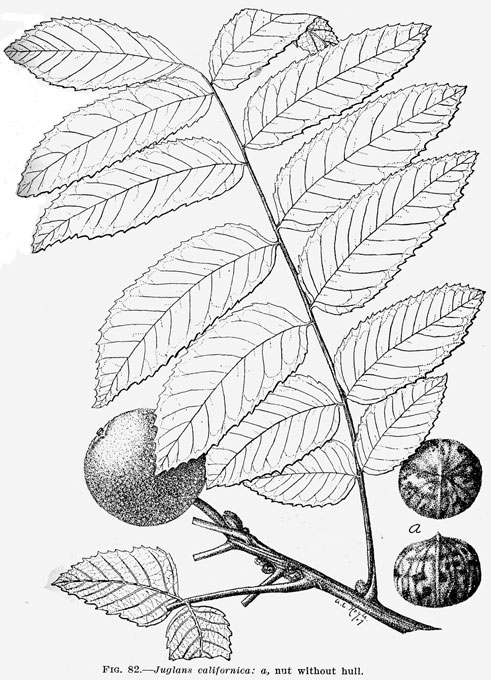Juglans hindsii
 Northern California black walnut
Northern California black walnut
Closely related to a shrubby species J. californica, which is widely distributed in Southern California, the Northern California black walnut is an erect single-trunked tree that is found in nature only on a few sites of Indian habitation (including Jasper Ridge), which makes one think that it may be a product of human selection. The numerous leaflets are quite unlike those of English walnut in general appearance, being lanceolate and 3 inches or so in length, with fine teeth. The bark is dark and rough and has a noticeable smell when abraded. The nut is smooth and hard and is embedded in a thick green husk that will stain the fingers. A large specimen grows at 541 Los Arboles Avenue, and many more are in the Sand Hill Road greenbelt, opposite the Stanford Shopping Center, from El Camino Real up to Ron McDonald House. In Palo Alto it can be seen at 950 Boyce Avenue and 2054 Hanover Street.
Walnut, pecan, and oak trees benefit when squirrels eat their nuts and acorns because the squirrels do not find all of the nuts that they so assiduously bury; some of the nuts germinate, contributing to the next generation of trees. Today we are the beneficiaries of millennia of unconscious plant breeding by squirrels that have selected for tasty kernels and thin shells; but the shells of the black walnut could still use more genetic help. In the Southern Hemisphere, by contrast, macadamia nuts and Brazil nuts developed formidable armor, especially the Brazil nuts, which are not only resistant to cracking with the teeth but are also enclosed, several at a time (up to 20 or so), in a tough woody coco weighing up to 5 pounds.
Illustrations: Jasper Ridge photo archive.
About this Entry: The main text of this entry is from the Juglans californica hindsii entry in the book Trees of Stanford and Environs, by Ronald Bracewell, published 2005. Hanover St location added, minor edits (Jul 2023, SP).




